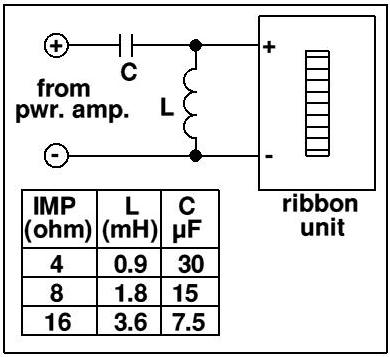Howard Dawson Audio
Maximising ribbon life by use of an adequate crossover
Bass Intolerance (applies to all traditional ribbons)
A ribbon tweeter has no mechanical restraint like that of a dome tweeter and is easily and instantly damaged by the tiniest residuals of bass in the signal. This means that crossover arrangements are particularly fussy if your ribbons are to last any length of time.
A simple test with an LF (20Hz) sine signal which is slowly increased in amplitude from zero shows that just-visible fluttering of the ribbon occurs at a power level of about 30 microwatts. You will agree this is "not a lot".
Such movement is what causes the ribbon to stretch and/or fracture. Therefore any application MUST ensure that this 30µW/20Hz condition is never exceeded.
Furthermore, mechanical movement would also affect sound quality by introducing intermodulation effects.
We do not need to worry too much about higher bass frequencies as the air loading on the ribbon increases with frequency, giving a higher permissible input before visible movement occurs.
This enables proposed crossovers to be evaluated on the basis of "How much 20Hz power can I apply to the input of my crossover such that I am left with 30µW at the tweeter output?"
6dB/octave (series capacitor) arrangements
You simply CANNOT use this arrangement - not even for 'supertweeter' use - here is the proof.
Imagine you have chosen a series capacitor to give a corner frequency of 10kHz.
Now calculate the number of octaves in the range 20Hz to 10kHz - I make it 9.
Our 6dB/octave arrangement therefore gives 9x6 = 54dB 'protection'.
The 20Hz input power that will cause ribbon movement is therefore 30µW + 54dB.
This evaluates to only 7.5W and is VERY likely to happen with all but the tiniest of amplifiers.
The ribbon will be destroyed or badly stretched instantly.
Decca Supertweeter owners should note that this is precisely why they chew through ribbons.
Fix them with a simple add-on filter as described here.
12dB/octave (series capacitor/parallel inductor) arrangements
This type is the accepted minimum (and sufficient) requirement and can cope with amplifiers of any sensible power output - here again is the proof.
Imagine you have chosen L and C values to give a 2.5kHz corner frequency.
Now calculate the number of octaves in the range 20Hz to 2.5kHz - I make it 7.
Our 12dB/octave arrangement therefore gives 7x12 = 84dB 'protection'.
The 20Hz input power that will cause ribbon movement is therefore 30µW + 84dB.
This evaluates to 7500W and is a VERY unlikely scenario.
Details of how to determine L and C values for 12dB/oct filters can be found here.
Active crossover arrangements
This is potentially a disaster waiting to happen. Because the filter is 'upstream' of the power amplifier, interfering or unwanted signals (such as hum or switch-on transients) can be presented to a directly-connected tweeter. If allowed to happen, you can be absolutely certain that this will destroy the ribbon instantly.
A secondary issue, if directly connected to a transistor amplifier, is that any DC offset (just a few millivolts) can cause problems because the DC resistance of the ribbon tweeter's transformer primary winding is very low indeed. Any such residual DC current in turn can cause nasty saturation effects in the transformer itself.
My suggestion to address both these issues would be to use a simple 12dB/octave filter between amplifier and tweeter, with a corner frequency well below your 'active' crossover frquency - maybe at 1kHz or so. This would then protect adequately against 'accidental' signals and also would AC-couple the tweeter to the amplifier, making the DC offset issue irrelevant.
The sketch shows a suitable 1kHz protection filter that can be used in a typical active tweeter drive.

......................
an example project using HRL-1
constructional details
JPEG images
information page
price list
home page
For further assistance or information :
Tel/Fax (01263) 734361
e-mail for further info
Please ensure you use a relevant subject line so that your message is not treated as spam, i.e. deleted unread.
If you send any attachments, e.g. photos, please try to keep total size below about 1Mb.
hand-crafted loudspeaker units for music lovers
